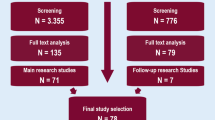Abstract
Sport and after school activities have been identified as fertile ground for adolescents to develop initiative and feelings of self-efficacy. The purpose of this article is to describe the development and implementation of a national intervention program that uses sport participation as a vehicle to enhance life skill development in urban youth. Evaluation data are provided and some potential advantages of using sport and after-school activities to promote social competence are discussed.
Similar content being viewed by others
REFERENCES
Carnegie Council. (1995). Great transitions: Preparing adolescents for a new century. (New York: Carnegie.
Cason, D., & Gillis, H. L. (1994). A meta-analysis of outdoor adventure programming with adolescents. Journal of Experiential Education, 17, 40–47.
Csikszentmihalyi, M., Rathunde, K., & Whalen, S. (1993). Talented teenagers: The roots of success and failure. (Cambridge, England: Cambridge University Press.
Danish, S. J., Nellen, V. C., & Owens, S. S. (1996). Teaching life skills through sport: Community-based programs for adolescents. In J. L. Van Raalte & B. W. Brewer (Eds.), Exploring sport and exercise psychology (pp. 205–225). Washington, DC: American Psychological.
Danish, S., Petitpas, A., & Hale, B. (1993). Life development interventions with athletes: Life skills through sports. The Counseling Psychologist, 21, 352–385.
Dishion, T., McCord, J., & Poulin, F. (1999). When interventions harm: Peer groups and problem behavior. American Psychologist, 54, 755–764.
Eccles, J. S., & Barber, B. L. (1999). Student council, volunteering, basketball, or marching band: What kind of extracurricular involvement matters? Journal of Adolescent Research, 14, 10–43.
Goldberg, A. D., & Chandler, C. (1995). Sports counseling: Enhancing the development of the high school student-athlete. Journal of Counseling and Development, 74, 39–44.
Hellstedt, J. (1998). The coach/parent/athlete relationship. The Sport Psychologist, 1, 151–160.
Howell, F., & McKensie, J. (1987). High school athletes and adult-sport leisure activity: Gender variations across the life cycle. Sociology of Sport Journal, 4, 329–346.
Huff, C. R. (1996). Gangs in America (2nd ed.). (Thousand Oaks, CA: Sage.
Kirshnit, C. E., Ham, M., & Richards, M. H. (1989). The sporting life: Athletic activities during early adolescence. Journal of Youth and Adolescence, 18, 601–615.
Larson, R. (2000). Toward a psychology of positive youth development. American Psychologist, 55(1), 170–183.
LeUnes, A., & Nation, J. R. (1983). Saturday's heroes: A psychological portrait of college football players. Journal of Sport Behavior, 5, 139–149.
Marsh, H. W. (1992). Extracurricular activities: Beneficial extension of the traditional curriculum or subversion of academic goals? Journal of Educational Psychology, 84, 553–562.
McPherson, B. D., Curtis, J. E., & Loy, J. W. (1989). The social significance of sport: An introduction to the sociology of sport. (Champaign, IL: Human.
Murray, B. (1997, September). Why are't antidrug programs working? APA Monitor, p. 30.
National Football Foundation. (1998). Play It Smart: Business Plan. (Morristown, NJ: National Football Foundation.
Petitpas, A. J., & Champagne, D. E. (2000). Sport and social competence. In S. J. Danish & T. P. Gullotta (Eds.), Developing competent youth and strong communities through after-school programming (pp. 115–137). Washington, DC: CWLA Press.
Petitpas, A. J., Danish, S. J., & Giges, B. (1999). The sport psychologist-athlete relationship: Implications for training. The Sport Psychologist, 13, 344–357.
Poinsett, A. (1996). The role of sports in youth development. (New York: Carnegie Corporation.
Wagner, W. G. (1996). Optimal development in adolescence: Where do we go from here? The Counseling Psychologist, 24, 462–466.
Weiss, M. R. (1995). Children in sport: An educational model. In S. M. Murphy (Ed.), Sport psychology interventions (pp. 39–69). Champaign, IL: Human Kinetics.
Author information
Authors and Affiliations
Rights and permissions
About this article
Cite this article
Petitpas, A.J., Van Raalte, J.L., Cornelius, A.E. et al. A Life Skills Development Program for High School Student-Athletes. The Journal of Primary Prevention 24, 325–334 (2004). https://doi.org/10.1023/B:JOPP.0000018053.94080.f3
Issue Date:
DOI: https://doi.org/10.1023/B:JOPP.0000018053.94080.f3




